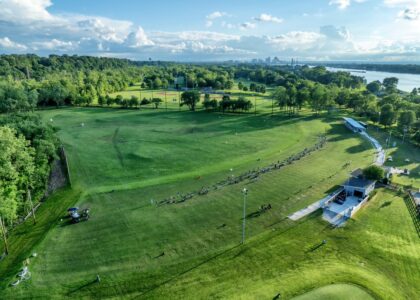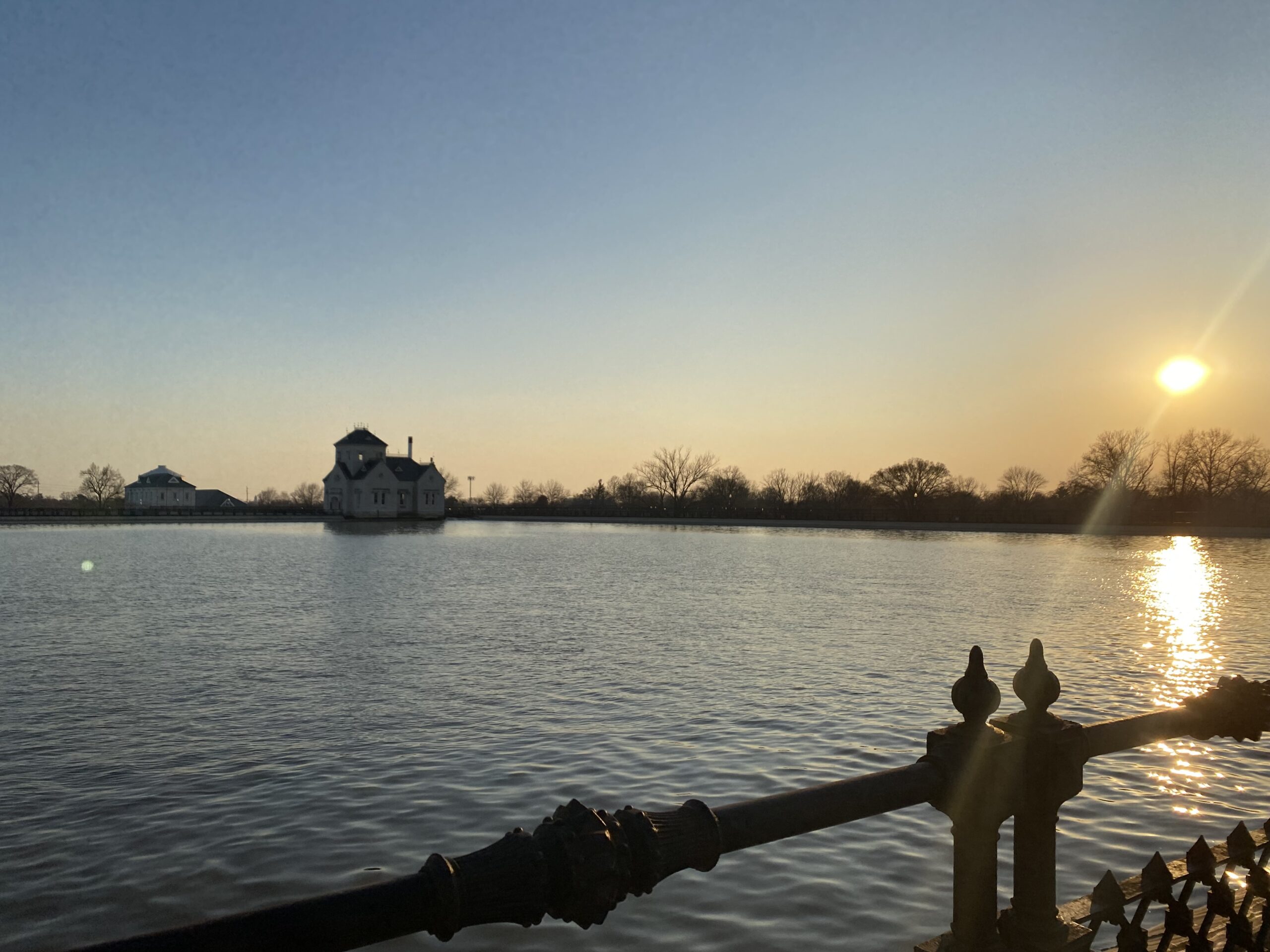Monday afternoon was the type of day I dreamed of when I left my longtime hometown of Louisville, Kentucky to settle in the nearby suburb of Jeffersonville, Indiana.
My dog, Jack, pulled me along from one tree to the next as we made our favorite walk down Riverside Drive in Historic Jeff. We passed under Interstate 65 and the Big Four bridge, waving to the familiar faces taking in the majestic Ohio River from their front porches.
Soon, Riverside Drive will be packed with thousands of people, dozens of vendors, and countless questionable outfit choices as Kentuckianians take in Thunder Over Louisville outside my back door.
But on this day, the bustle was limited to the locals, enjoying spring’s reprieve from the harsh elements, gladly replacing it with the stench of blooming Bradford Pears and the not-so-subtle waft of Butchertown air blowing across the Ohio.
On Monday, however, I tried to take in the skyline a little more than usual. And stifled the emotion that weighed on me from the most gruesome day of my lifetime.
One that I don’t soon hope to forget.
Preston Pointe has been a building more prominent in my life than I notice day to day.
You may know it as that peculiar building with the massive 13-story roof, but it’s one of the more prominent pieces of architecture on the west side of downtown “designed to emphasize the kinetic energy of the waterfront”.
I pass Preston Pointe nearly every day. I park near the building on frequent trips to the KFC Yum! Center, the waterfront, and neighboring Louisville Slugger Field.
When I worked downtown, my office overlooked Preston Pointe, and one of my co-workers lived in one of the four residential condos atop the building.
Monday morning, as I often do, I sat on my balcony with Jack, taking in the river, the fresh spring air, and the skyline from the Falls of the Ohio to the Ali Center, all the way across to Slugger Field, and, yes, Preston Pointe.
I drove by the building en route to work, as thousands of others did, not knowing of one of the deadliest mass shootings in the history of our area would take place at 8:30 AM Monday morning.
I know that this is something that has happened thousands of times. That I could turn on the news or open social media at any given moment, and another mass shooting will have taken place. But that’s somewhere else. Some other community full of people that I don’t know. But, I can’t let something that happens frequently bog down my day. So I change the channel. Or turn off the TV. Or keep scrolling. Or put down my phone. And I choose to forget- Until the next time. And the process repeats itself.
Somewhere in another city in America, someone is grabbing their last morning paper. They are unknowingly eating their last breakfast with their spouse or their children. They are drinking their last coffee, and embarking on their last car, train, or bus ride.
They are as blissfully unaware that their brains will be splattered against the wall and blood spilled onto the floor in a matter of minutes or hours as the rest of us. And elsewhere around the country, we will pause, if only briefly enough to keep scrolling or change the channel.
We might feel angry. We may even tweet about it or share the news on our favorite social medium. Maybe we will call a loved one. But, if you’re anything like me, you’ll keep it moving. Because the sensation has worn on you for far too long, the anger has weighed you down far too many times, and, like me, you realize that life is going to go on whether you stop to mourn or not.
I couldn’t quite put my finger on exactly what it was that wrecked me so hard on Monday morning when the details of the deadliest mass shooting in Louisville since 1989 began to emerge.
One would hope it’s the fact that this conversation ever has to be a “deadliest since…” one.
But it’s not.
You’d hope that it’s because Joshua Barrick, Thomas Elliott, Juliana Farmer, James Tutt, and Deana Eckert had their lives so unjustly ended during a mundane Monday meeting. Or because others, like officer Nickolas Wilt — who was in his 10th day on the job — are fighting for their lives at the same hospital where I go for a routine check-up.
But it wasn’t.
Those things certainly weighed on me. We are already hearing dozens of stories surfacing about what the victims contributed to the community. How much they loved the family and friends that they left behind.
Those are wounds that will never properly heal in this community.
But the thing that weighed on me the most- that it will take me the longest to look past- is the killer himself.
It’s torn me apart from the inside out. It started as a skipped heartbeat and turned into an ache in my stomach that grew into a heaviness in my chest and a lump in my throat.
I sat at my desk on Monday going through the motions as uninterested as I ever have. Because I couldn’t stop thinking about his face. I couldn’t look away from a monitor where pictures from his LinkedIn and Instagram accounts stared through me.
I still can’t stop thinking about him. Because the killer? He’s me.
Connor Sturgeon looked like me. He was in the same place in life as me. He had similar life experiences and worldviews. He grew up in the same area, undoubtedly running with similar groups of friends.
Sturgeon was a graduate of Floyd Central High School, just minutes from my home. He was well-educated and just getting his career off the ground.
He was a high school basketball player whose family was well-known in the community. His father was a tenured coach at the University of Indianapolis who stepped down to coach his son and teach history at Floyd Central. He had just recently stepped down from his coaching role at the school.
The younger Sturgeon even struggled with the same issues that I, and many others our age do.
“My self-esteem has long been a problem for me,” Sturgeon wrote in a blog post during college. “As a late bloomer in middle and high school, I struggled to a certain extent to fit in, and this has given me a somewhat negative self-image that persists today.”
He worked in a building one block from where I used to work. A place that I see and pass daily.
And on a morning when we’d undoubtedly normally go through similar routines, Sturgeon decided that his life, and the lives of dozens of others, were no longer worth living.
I can’t stop thinking about Connor Sturgeon because I don’t want to.
I don’t want to forget. I don’t want to heal from this. I don’t want this feeling to become another scab that eventually turns into another almost imperceptible scar on my heart.
I want to know that every time another mass shooting happens that I will think of Connor Sturgeon. And I will think of the fact that he’s me. Because so many of these killers are me.
White. Male. Young. Impressionable. A product of a fast-paced, social media-crazed generation.
Of all mass shootings to take place in the United States since 1985, 73 percent of the killers were white, and 95 percent of them were men. The average age of the killers is 33.
I can’t forget that the killer… is me.
And I can’t allow myself to not be angry any longer. I can’t grow numb to the fact that mass shootings happen in my country as often as I wake up in the morning.
I cannot stop thinking about and caring about the fact that this is the only nation in the world where this problem persists.
And that, although the solutions to the problem are right in front of us, laid out plainly, our leaders will continue to turn a blind eye to it.
I can’t, and won’t ever stop thinking about the fact that the United States has the most expensive healthcare in the world. That I routinely put off going to the doctor because of the expense. And that many have never considered mental healthcare because it may never be in their budget.
I can’t and won’t ever stop thinking about the fact that Kentucky is one of 26 states that allow permitless gun carry. That, as long as you’re not a convicted felon, you can purchase a gun. That there are no classes required to show you how to properly use or handle a firearm.
I can’t, and will never forget that Sturgeon purchased the weapon that he used to carry out a massacre on Tuesday, April 4th, and took those lives less than 6 days later.
I won’t forget that his father’s latest post on social media was a video of San Antonio Spurs coach Gregg Popovich showing concern over the uptick in recent gun violence. In the video, Popovich says of the Second Amendment: “a myth, it’s a joke, it’s just a game they play. I mean, that’s freedom. Is it freedom for kids to go to school and try to socialize and try to learn and be scared to death that they might die that day?”
I can’t stop thinking about the fact that the United States has a problem with feasible and extremely attainable solutions. Yet, after years of the same issues, we are further now from resolving the issues than even a decade ago.
If the issue is guns, let’s work to make them less accessible.
If the issue is mental health, let’s work to make those solutions more accessible.
At this point, I don’t care what the answer is as long as we are actively working to resolve an increasingly troubling problem.
Today, thousands of loved ones in the city of Louisville mourn.
Dozens work to save the lives of the remaining hospitalized victims.
Co-workers, families, police, and medical personnel will never be the same.
As for me? I plan to continue to be enraged. To remember when I learn of the next slaughtering that both the killer and the victims, more than likely, could have been me. And that if people like you and I don’t actively work to stop things, the pain will persist and the problem will continue.
When Jack and I take our next walk or look out our window at the Preston Pointe building, I want this moment to change me. I don’t just want life to go on.
And when you look across our skyline and take in our home, I hope that it forever changes you, too.






One thought on “Why the Louisville mass shooting will change me forever”